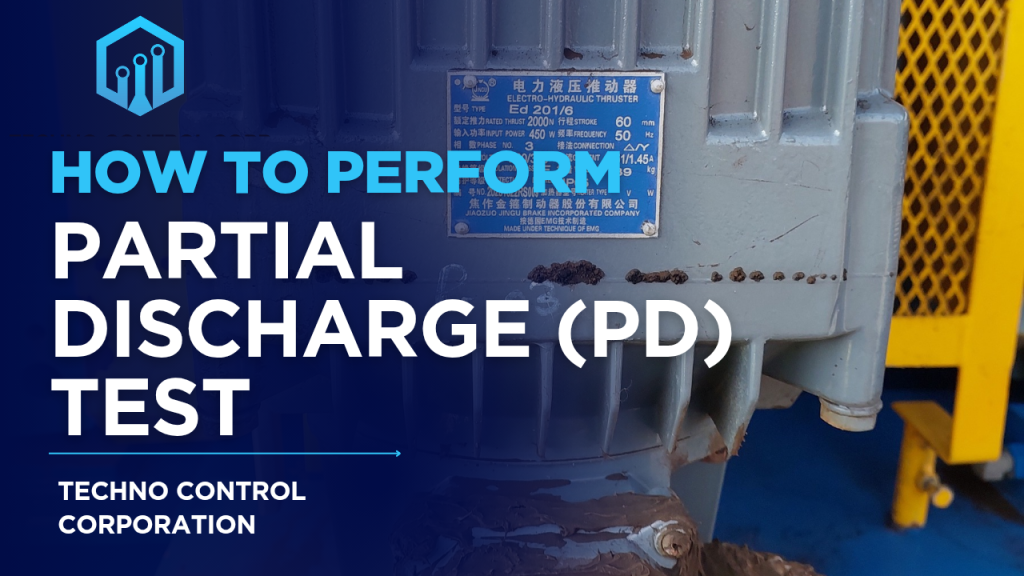insulation defects in electric motors. Unlike traditional insulation tests, PD testing identifies localized electrical discharges that occur within insulation materials before a complete breakdown happens.
This article will cover the importance, procedure, and benefits of the Partial Discharge Test and why it is essential for maintaining motor reliability and efficiency.
Why Is the Partial Discharge (PD) Test Important?
Over time, motor insulation is exposed to high voltages, thermal stress, moisture, and contamination, leading to microvoids or weak spots. These areas can initiate partial discharges, which degrade insulation and eventually cause motor failure.
The PD test is essential for:
- Detecting early-stage insulation defects before complete failure.
- Identifying voids, cracks, and electrical treeing inside insulation.
- Preventing catastrophic failures and unplanned downtime.
- Ensuring compliance with IEC 60034-27 and IEEE 1434 standards for motor insulation testing.
Unlike Tan-Delta or Insulation Resistance Tests, which measure overall insulation health, PD testing pinpoints localized defects, making it a more precise tool for predictive maintenance.
How to Perform a Partial Discharge (PD) Test?
Equipment Needed:
- Partial Discharge Analyzer (Omicron, Megger, or Doble test sets)
- High-voltage power supply
- Capacitive or inductive sensors
- Oscilloscope or PD measurement software
Step-by-Step Procedure:
- Prepare the Motor:
- Disconnect the motor from the power source.
- Clean the motor terminals to remove contamination.
- Ensure a proper grounding system to avoid electrical noise.
- Install PD Sensors:
- Capacitive Sensors – Used for high-voltage motors.
- Inductive Sensors – Installed on motor stator windings to detect PD pulses.
- Apply Test Voltage:
- Apply a high voltage (similar to operating voltage) to the motor windings.
- Gradually increase the voltage while monitoring for PD activity.
- Measure PD Activity:
- The PD analyzer records electrical discharges occurring inside the insulation.
- Readings are displayed in picoCoulombs (pC), indicating the severity of partial discharges.
- Evaluate the Test Results:
- Compare PD readings with acceptable limits (per IEEE/IEC standards).
- Consistent PD activity at low voltages suggests insulation degradation.
- Increasing PD levels at higher voltages indicate severe insulation damage.
Interpreting Partial Discharge Test Results
| Partial Discharge Level (pC) | Insulation Condition |
| < 50 pC | Excellent (Healthy insulation) |
| 50 – 200 pC | Good (Minor PD activity, but insulation is stable) |
| 200 – 500 pC | Moderate (Some degradation, requires monitoring) |
| > 500 pC | Poor (Severe insulation breakdown, immediate action needed) |
Benefits of the Partial Discharge (PD) Test
✅ Early Fault Detection – Identifies insulation issues before they cause failures.
✅ Pinpoints Exact Defect Locations – Helps technicians target repairs.
✅ Extends Motor Lifespan – Prevents long-term insulation damage.
✅ Reduces Downtime & Costs – Avoids unexpected motor failures in industries.
✅ Ensures Compliance with IEEE & IEC Standards – Required for critical applications.
Best Practices for Partial Discharge Testing
- Perform PD testing periodically to monitor insulation condition over time.
- Use multiple sensors (capacitive & inductive) for accurate readings.
- Conduct tests in a low-noise environment to eliminate interference.
- Compare new test results with historical data to detect insulation aging trends.
- If PD activity is high, consider insulation reconditioning or replacement.
Conclusion
The Partial Discharge Test is a powerful tool for assessing motor insulation quality and detecting hidden defects before they lead to breakdowns. By incorporating PD testing into routine maintenance, industries can reduce failures, increase reliability, and improve overall motor performance.
Predictive maintenance using Partial Discharge Analysis helps businesses save thousands in repair costs while ensuring motors operate safely and efficiently.

